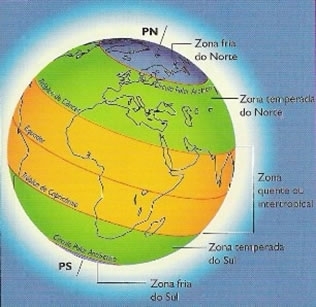 At thermal zones are the different zones of light intensity and heat that the Earth receives from the sun. Thermal zones or lighting zones are divided into: Arctic Polar Zone, Northern Temperate Zone, Tropical Zone or Intertropical, Southern Temperate Zone and Antarctic Polar Zone.
At thermal zones are the different zones of light intensity and heat that the Earth receives from the sun. Thermal zones or lighting zones are divided into: Arctic Polar Zone, Northern Temperate Zone, Tropical Zone or Intertropical, Southern Temperate Zone and Antarctic Polar Zone.
Because of the tilt of the axis and the rounded shape of the Earth, light and heat from the Sun do not reach all places on the planet with the same intensity.
At the poles and in the regions close to them, the sun's rays reach the Earth's surface in a very inclined way and, by this reason the amount of heat is lower, this explains the formation of ice caps near the North and South.
The amount of light that reaches the surface in areas close to the equator receive a lot of heat and are brighter throughout the year.
The Northern Temperate Zones and the Southern Temperate Zone are intermediate regions between the less and more illuminated regions.
The term thermal zones is currently being called lighting zone, as there are other factors that influence the temperature of the atmospheric air in a place. For example, a large part of the Andes Mountains, in South America, lies between the tropics of Cancer and Capricorn, that is, in the tropical or intertropical zone. However, due to the altitude of these mountains and high plateaus, low temperatures prevail there.
